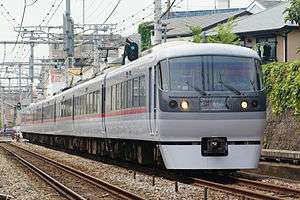Seibu 2000 series
The Seibu 2000 series (西武2000系) is an electric multiple unit (EMU) train type operated by the private railway operator Seibu Railway on commuter services in the Tokyo area of Japan since 1977.[1]
| Seibu 2000 series | |
|---|---|
 A later-batch type 2000 series EMU on the Seibu Shinjuku Line in June 2012 | |
| Manufacturer | Seibu Tokorozawa Railway Works, Tokyu Car Corporation |
| Constructed | 1977-1992 |
| Entered service | 1977 |
| Number built | 444 vehicles |
| Number in service | 406 vehicles (as of 1 April 2016) |
| Number preserved | 1 vehicle (cab end) |
| Formation | 2/4/6/8 cars per trainset |
| Operator(s) | Seibu Railway |
| Depot(s) | Kotesashi, Musashigaoka, Minami-Iriso, Tamagawa-Josui |
| Line(s) served | Seibu Ikebukuro Line, Seibu Shinjuku Line |
| Specifications | |
| Car body construction | Steel |
| Car length | 20 m (65 ft 7 in) |
| Doors | 4 pairs per side |
| Maximum speed | 105 km/h (65 mph) |
| Traction system | Chopper control Variable frequency (GTO) |
| Electric system(s) | 1,500 V DC |
| Current collection method | overhead catenary |
| Track gauge | 1,067 mm (3 ft 6 in) |
Design
The 2000 series trains were introduced on all-station stopping services on the Seibu Shinjuku Line in 1977, featuring four pairs of sliding doors on each side to speed up boarding and alighting at stations.[1] 130 vehicles were built between 1977 and 1988, including some replacements for cars damaged in accidents, and this first batch was followed by a batch of 304 vehicles classified "New 2000 series" built between 1988 and 1992.[1]
- A first-batch type 2000 series set in May 2015
 8-car "New 2000 series" set 2095 on the Seibu Shinjuku Line in March 2016
8-car "New 2000 series" set 2095 on the Seibu Shinjuku Line in March 2016
Fleet
As of 1 April 2016, the fleet consists of 406 vehicles formed as two-car, four-car, six-car, and eight-car sets, and based at Kotesashi, Musashigaoka, Minami-Iriso, Tamagawa-Josui depots for use on Seibu Shinjuku Line and Seibu Ikebukuro Line workings.[2]
Formations
Sets are formed as two-car, four-car, six-car, and eight-car sets, as shown below.[2]
Four-car sets
| Designation | Mc | M2 | M3 | Tc2 |
|---|---|---|---|---|
| Numbering | 25xx | 25xx | 26xx | 26xx |
The "M3" cars each have two lozenge-type pantographs.[2]
Six-car sets
| Designation | Tc1 | M1 | M2 | M5 | M6 | Tc2 |
|---|---|---|---|---|---|---|
| Numbering | 20xx | 21xx | 21xx | 22xx | 22xx | 20xx |
The "M1" and "M5" cars each have two single-arm pantographs.[2]
Eight-car sets
| Designation | Tc1 | M1 | M2 | M3 | M4 | M5 | M6 | Tc2 |
|---|---|---|---|---|---|---|---|---|
| Numbering | 20xx | 21xx | 21xx | 22xx | 22xx | 23xx | 23xx | 20xx |
The "M3", "M3", and "M5" cars each have one pantograph.[2]
Interior
Seating consists of longitudinal bench seating throughout. Priority seats are provided at the end of each car.[2]
History
The first trains entered service in 1977 on the Seibu Shinjuku Line, initially formed as six-car sets.[1]
Preserved examples
.jpg)
The cab end of former car KuHa 2098 is preserved inside the Maruzen Ikebukuro bookshop in Toshima, Tokyo. Built in June 1992 at Seibu Railway's Tokorozawa factory, it was withdrawn in September 2016, and moved to the ground floor of the Maruzen Ikebukuro bookshop building in March 2017, while still under construction.[3]
References
- 私鉄車両年鑑2015 [Japan Private Railways Annual 2015] (in Japanese). Tokyo, Japan: Ikaros Publications Ltd. 20 June 2015. p. 169. ISBN 978-4-8022-0003-5.
- 私鉄車両編成表 2016 [Private Railway Rolling Stock Formations - 2016] (in Japanese). Japan: Kotsu Shimbunsha. 25 July 2016. pp. 48–52. ISBN 978-4-330-70116-5.
- Goto, Fumio (October 2017). 東京・池袋 ビルに入った3台の電車 [The three trains inside a building in Ikebukuro, Tokyo]. Japan Railfan Magazine (in Japanese). Vol. 57 no. 678. Japan: Koyusha Co., Ltd. pp. 78–81.
External links
| Wikimedia Commons has media related to Seibu 2000 series. |
- Seibu 2000 series train information (in Japanese)
